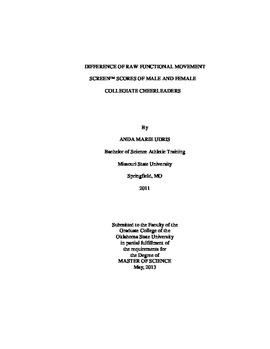| dc.description.abstract | Context: Cheerleading is a sport that requires mobility, stability, and neuromuscular control. Many collegiate athletes perform pre-participation exams as proactive preventative measures prior to competition, which may include an evaluation called the Functional Movement Screen<sup>TM</sup>. Objective: The purpose of this study was to assess the difference of FMS<sup>TM</sup> scores of cheerleaders at four different universities. Setting: Mid-west universities that had competitive cheerleading squads. Participants: One hundred and thirty-one healthy male and female athletes were recruited (Males= 51, Females=80). One female participant was removed due to a modified screening procedure. Interventions: Prior to participation, participants filled out pre-participation survey. After watching an explanatory video for each movement, a single researcher took each participant through the FMS<sup>TM</sup> patterns and clearing tests, in order. Main Outcome: There was statistical significance in FMS<sup>TM</sup> scores between genders and positions. However, the data found no significance in scores between universities, squads, competitive company, or years of general and collegiate experience. Measures: Each movement was scored on a summed numerical scale. When doubt was perceived regarding scoring, participants were scored low. Results: Data was successfully collected from four different universities and six different squads (n= 130). For all universities, the FMS<sup>TM</sup> scoring average was above the risk indicating score of 14 (15 ? 2.64). Data analysis indicated that there was no significant difference between scores of universities [F (3,126), p= .590], squad, total years cheerleading [F (15,114), p= .671], total collegiate years cheerleading [F (6,123), p= .426], amount of competitive teams participant currently cheers [F (1,128), p= .817], or designated competitive company [F (1,128), p= .980]. There was a significant difference in scores for gender [F (1,128) = 11.22, p = .001] and position [F (4,125) = 9.26, p = .000]. Conclusions: The findings of this study indicated that location, coaching, and training regimen did not create a significant difference in FMS<sup>TM</sup> scores amongst college cheerleaders. However, it did support the sport as an athletic activity that inherently requires significant stability and mobility. Increased understanding of functional movement patterns, mobility, stability, and injury prevention will aid in the development of rehabilitation and strengthening programs. | |
